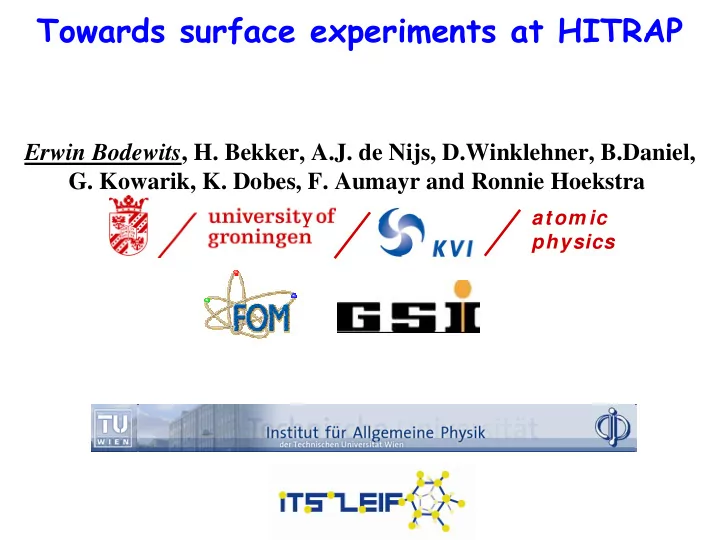

Towards surface experiments at HITRAP Erwin Bodewits , H. Bekker, A.J. de Nijs, D.Winklehner, B.Daniel, G. Kowarik, K. Dobes, F. Aumayr and Ronnie Hoekstra atom ic physics
Introduction � HITRAP - GSI � Facility for slow highly charged ions (kinetic energy ~keV, potential energy up to 1MeV!) � Electron dynamics � Metallic vs. insulating surfaces � Electron capture according to the classical over the barrier model � New IISIS set up � First results on C 60 /Au system
Artistic impression Hollow atom formation Tim e � All processes happen on a femtosecond scale
Some electronic processes according to the classical over the barrier model Burgdörfer et al, PRA 4 4 (1991) 5647 distance of first electron capture: D= (2q) 1/ 2 / W φ into the shell n ≈ q High q – (very) large distance when first capture occurs
IISIS: multi-user station for HITRAP Inelastic Ion Surface Interactions Set-up Target manipulator El.Stat.Det. surface analysis evaporator X-ray det.
IISIS: electron statistics detection Number k probability Xe 12+ Number of electrons N 3+ Aumayr et al. Intensity
IISIS: first electron yield data Xe q+ - Au Electron yield Intensity O 3+ Xe 24+ Charge state Meissl et al , J. Surf. Sci. Nanotech 6 (2008) 54 Number of electrons
12xq keV Xe q+ - Au γ vs E pot γ /q vs q Electron yield (electron/ion) Yield (electrons/ion charge) Potential energy (eV) Charge state 4d shell 4p shell slope 140 ~70 eV/emitted electron
First data on C 60 films on Au Changing the electronic structure Film production (Omicron evaporator) in situ calibration evaporation on quartz microbalance comparison to 1ML C60 produced via “heating recipe” 7xq keV Xe q+ - C60/ Au at different angles of incidence: 10 o , 45 o and 60 o q= 10 q= 16 q= 23 Yield Yield Yield Number of monolayers Number of monolayers Number of monolayers
Relative electron yield versus C60 coverage 7xq keV Xe q+ - C60/ Au films 10+ 16+ 23+ Number of monolayers
Insulator versus metal W f Metal C 60 capture distance – states/ time resonant ionization secondary electrons escape depth
conclusions I I SI S I nelastic I on Surface I nteractions Set-up electron statistics detection at low energy first tests on C6 0 / Au succesfull rem aining issues: Further characterization of the film / surfaces full scale sim ulations at low energy ( inc. angle, position of beam ,...) incorporation of X-ray detection
Thank you for you attention!
densities of states Maxwell et al , PRB 4 9 (1994) 10717
IISIS: deceleration and transport
Experiments at HITRAP Exotic, spin-polarized hollow atoms TRAMPOLINE effect Magnetized surfaces on insulators metals vs. insulators Thin films Surface lithography
first generation of experiments Not yet optimal HITRAP beams No hard constraints on beam energies THIN FILMS: bridges between Surface lithography metals and insulators electron statistics microscopy (in collaboration with Aumayr et al (Vienna)) simultaneously look for X ray spectra (in collaboration with Stöhlker et al (GSI))
Some electron capture processes according to the classical over the barrier model electron resonant Auger neutralization Radiative transition ionization/neutralization distance of first electron capture: D= (2q) 1/ 2 / W φ into n ≈ q Auto ionization Auger deexcitation
Eder et al , NIMB 1 5 4 (1999) 185 kinetic emission threshold ~ 0.3 keV/ amu electronic KE eKE collisional KE cKE potential energy em ission PE ~4keV ~100keV
First data on C60 films on Au Film production (Omicron evaporator) in situ calibration evaporation on quartz microbalance comparison to 1ML C60 produced via “heating recipe” 168 keV Xe 24+ - 1 ML C60/ Au kinetic electron emission: γ = γ 0 + γ θ cos -1 θ potential electron emission: γ= γ 0 + γ θ cos −0.5 θ
Recommend
More recommend